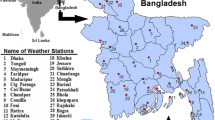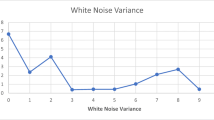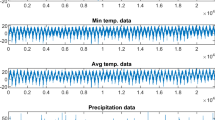Abstract
The present study reports a two-state Markov chain approach as well as an autoregressive approach to study the behavior of the surface temperature time series over northeast India. Considering the minimum requirement of the chi-square test, 1998–2007 (> 100 months) have been considered for testing the Markovian and autoregressive behavior. The monthly surface temperature time series involves monthly data that corresponds to a continuous random variable. This random variable has been discretized to binary data, and the transition probabilities have been computed up to the fourth-order Markov chain model. The best order of Markov chain has been derived through the minimization of the Bayesian information criterion (BIC). By analyzing the time series autocorrelation function and the Akaike information criteria (AIC), the autoregressive model of order two has been found to be a representative and the best autoregressive method for the average monthly time series of surface temperatures over northeast India.




Similar content being viewed by others
References
Aghelpour P, Mohammadi B, Biazar SM (2019) Long-term monthly average temperature forecasting in some climate types of Iran, using the models SARIMA, SVR, and SVR-FA. Theor Appl Climatol 138(3–4):1471–1480
Biao EI, Alamou EA (2018) Stochastic modelling of daily rainfall for decision making in water management in Benin (West Africa). Res Adv: Environ Sci 1:12–21
Chen S, Chung G, Kim BS, Kim TW (2019) Modified analogue forecasting in the hidden Markov framework for meteorological droughts. SCIENCE CHINA Technol Sci 62(1):151–162
Dash SK, Jenamani RK, Kalsi SR, Panda SK (2007) Some evidence of climate change in twentieth-century India. Clim Chang 85(3–4):299–321
Karmakar S, Goswami S, Chattopadhyay S (2019) Exploring the pre- and summer-monsoon surface air temperature over eastern India using Shannon entropy and temporal Hurst exponents through rescaled range analysis. Atmos Res 217:57–62
Khadr M (2016) Forecasting of meteorological drought using hidden Markov model (case study: The upper Blue Nileriver basin, Ethiopia). Ain Shams Eng J 7:47–56
Kothawale DR, Revadekar JV, Kumar KR (2010) Recent trends in pre-monsoon daily temperature extremes over India. J Earth System Sci 119(1):51–65
Kothawale DR, Rupa Kumar K (2005) On the recent changes in surface temperature trends over India. Geophys Res Lett 32(18)
Kulkarni MK, Kandalgaonkar SS, Tinmaker MIR, Nath A (2002) Markov chain models for pre-monsoon season thunderstorms over Pune. Int J Climatol 22:1415–1420
Lu N, Liang S, Huang G, Qin J, Yao L, Wang D, Yang K (2018) Hierarchical Bayesian space-time estimation of monthly maximum and minimum surface air temperature. Remote Sens Environ 211:48–58
Mondal A, Khare D, Kundu S (2015) Spatial and temporal analysis of rainfall and temperature trend of India. Theor Appl Climatol 122(1–2):143–158
Paoli C, Voyant C, Muselli M, Nivet ML (2010) Forecasting of preprocessed daily solar radiation time series using neural networks. Sol Energy 84(12):2146–2160
Prakash S, Norouzi H (2019) Land surface temperature variability across India: a remote sensing satellite perspective. Theor Appl Climatol. https://doi.org/10.1007/s00704-019-03010-8(onlinefirst)
Richardson D, Fowler HJ, Kilsby CG, Neal R, Dankers R (2020) Improving sub-seasonal forecast skill of meteorological drought: a weather pattern approach. Nat Hazards Earth Syst Sci 20(1):107–124
Ross RS, Krishnamurti TN, Pattnaik S, Pai DS (2018) Decadal surface temperature trends in India based on a new high-resolution data set. Sci Rep 8(1):7452
Schoof JT, Pryor SC (2008) On the proper order of Markov chain model for daily precipitation occurrence in the contiguous United States. J Appl Meteorol Climatol 47(9):2477–2486
Varotsos C, Ondov J, Efstathiou M (2005) Scaling properties of air pollution in Athens, Greece and Baltimore, Maryland. Atmos Environ 39:4041–4047
Villarini G, Serinaldi F, Smith JA, Krajewski WF (2009) On the stationarity of annual food peaks in the continental United States during the 20th century. Water Resour Res 45:W08417. https://doi.org/10.1029/2008WR007645
Wilks DS (2006) Statistical methods in the atmospheric sciences. Academic Press
Yue S, Pilon P (2004) A comparison of the power of the t test, Mann-Kendall and bootstrap tests for trend detection. Hydrologic Sci J 49(1):21–37. https://doi.org/10.1623/hysj.49.1.21.53996
Acknowledgments
The authors sincerely acknowledge the constructive suggestions by the anonymous reviewers. The data are collected from the website of the Indian Institute of Tropical Meteorology (IITM), Pune (https://tropmet.res.in/static_pages.php?page_id=54).
Author information
Authors and Affiliations
Contributions
Surajit Chattopadhyay (SJC) has mentored the work. The problem and methodology have been designed by SJC. The methodology has been implemented jointly by the first and second authors under the guidance of SJC. The text has been finalized jointly by the three authors, and all have equal contribution in preparation of the text, figures and tables.
Corresponding author
Ethics declarations
Conflict of interest
The authors declare that they have no conflict of interest.
Additional information
Publisher’s note
Springer Nature remains neutral with regard to jurisdictional claims in published maps and institutional affiliations.
Rights and permissions
About this article
Cite this article
Ray, S.N., Bose, S. & Chattopadhyay, S. A Markov chain approach to the predictability of surface temperature over the northeastern part of India. Theor Appl Climatol 143, 861–868 (2021). https://doi.org/10.1007/s00704-020-03458-z
Received:
Accepted:
Published:
Issue Date:
DOI: https://doi.org/10.1007/s00704-020-03458-z




